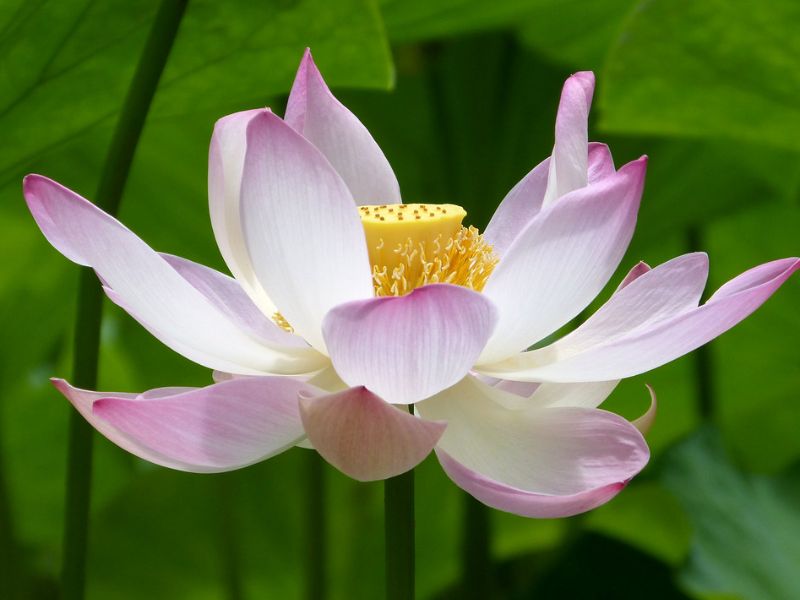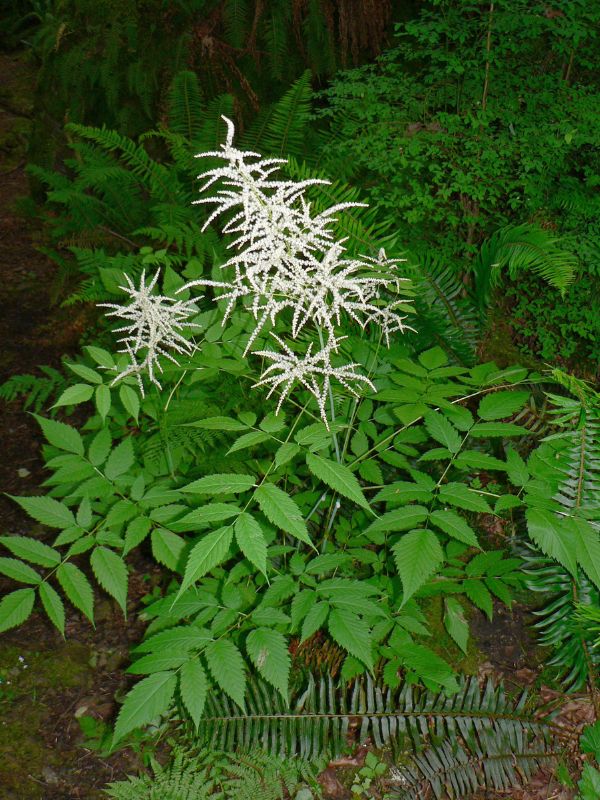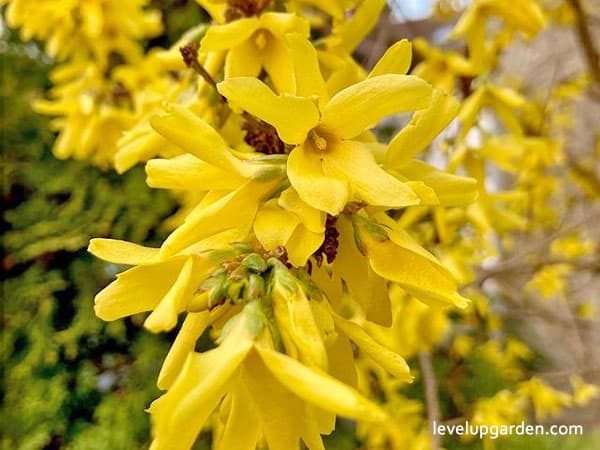Christmas Palms or Adonidia merrillii Information can be planted in your landscape and provide an unparalleled tropical flair. Learn more about its profile, appearance, growing and caring conditions, uses, and the reasons why you should or shouldn’t plant the tree in your garden in this guide.
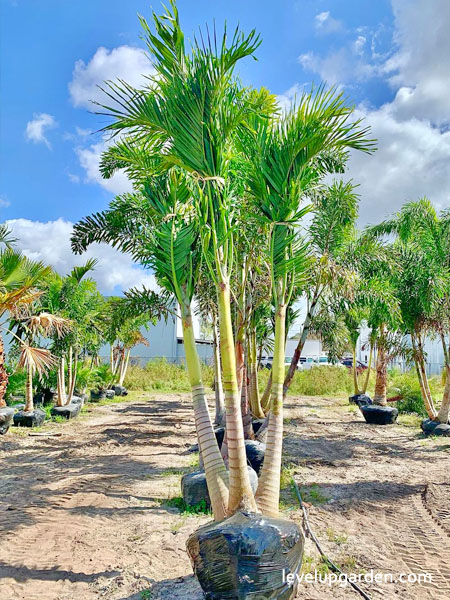
Adonidia merrillii has the common name “Christmas palm,” referring to the time of year when the green fruits turn red. Since it is susceptible to frost and freezing, it should be planted in containers that can be moved indoors during the winter.
Whether you plant them in containers and bring them indoors or place them on your porch or patio, they will come alive with crowns large enough to create a shady, relaxing area. Ideal for tight or compact spaces, such as near sidewalks or driveways, this palm takes up little space and doesn’t get too big, unlike other varieties.
And most importantly, Christmas palms don’t require much care. Your only job is to pick the perfect spot. Before you know it, you will have a mature, elegant palm tree in your home landscape, making a beautiful statement. Even better, it will bear little berries that turn bright red at Christmas.
I. Christmas Palm Profile – An Overview of the plant
| Common Names | Christmas palm, Christmas tree palm |
| Botanical Name | Adonidia merrillii |
| Genus | Adonidia |
| Species | merrillii |
| Family | Arecaceae |
| Plant Type | Tree |
| Mature Height | 10-25 ft |
| Mature Width | 6-8 ft |
| Sunlight | Full-Partial |
| Light | Full sun (6 or more hours of direct sunlight a day) |
| Soil Texture | Clay, Loam (Silt), Sand |
| Soil pH | Acid, Alkaline, Neutral |
| Growth Rate | Medium |
| Maintenance | Low |
II. Christmas Palm Appearance
It grows rapidly to about 6 feet (1.83 m) with a slender gray trunk and then slowly retains its form, reaching a maximum height of 25 feet (7.62 m). The palm tree stands alone, supporting stiffly arching green leaves 4 to 5 feet long.
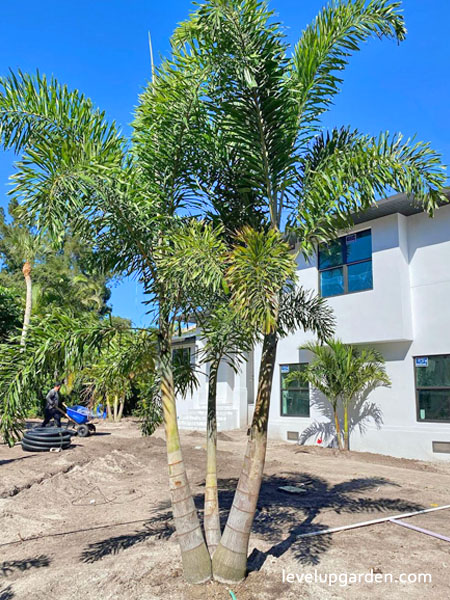
In midsummer, inconspicuous cream-colored flowers bloom at the base of the canopy and produce 2.54-cm green berries. In winter, the mature fruits turn bright red. It is possible to group three single-trunked palms together to form a multi-trunked palm.
- Leaf: The 4-5 foot arching green pinnate leaves have short soft hairs on the petioles, which are attached upward in a V-shape when viewed from the edge of the leaf. The upper leaves have a prominent midrib. The tips of the leaf blade are irregularly jagged.
- Fruit: Fruits with egg-shaped beaks grow in clusters. The unripe fruits are pale green and ripen to scarlet red around Christmas, giving it the common name Christmas palm.
- Flower: In summer, small, cream-colored, inconspicuous, complete flowers (each flower has a male and female part) bloom in the canopy case, followed by light green, 1-inch fruits.
III. Growing and Care Conditions of Christmas palms
Since it is susceptible to frost and freezing, it is best to plant it in containers that can be moved indoors during the winter.
Planting
Dig a slightly shallower hole, 2 to 3 times the width of the rootball. Backfill with compacted soil, keeping the tree upright. After you are done, water to settle the soil and then remove any air pockets. For growing outdoors, be sure to provide well-drained soil and plenty of space at the top.
Watering
In addition to normal watering, water the Christmas palms with a mist once a week if they are kept indoors to reproduce their natural humid climate in the house. If you are unsure of the timing of watering, check the condition of the soil approximately 15 cm below. When the soil is dry here, you know it is time to water.

Sun Exposure
It is recommended to choose a sunny location (at least 4-6 hours per day) in cold climates and a location with indirect sunlight in warm climates.
Fertilizer
Fertilizers for Christmas palms can contain specific nutrients that are best suited for palms. In addition, balanced fertilizer such as an 8-8-8 formula can be used during the spring and summer months for faster growth.
Pruning
Christmas palms do not require much pruning except for removing damaged leaves. Be careful not to pull out dead or damaged leaves, and always cut off damaged leaves with disinfected, sharp pruning shears.
Pests and Diseases
They are susceptible to a bacterial incurable disease called lethal yellowness. It may also suffer from boron deficiency. When grown in low nutrient soils, use a fertilizer specifically designed for palms.
IV. Christmas Palm Uses
Christmas palm trees are excellent for small residential landscapes and they can be used as street trees in tropical climates.
V. Should I buy a Christmas Palm? Is this the tree for your garden?
Christmas palms bring a fresh tropical breeze to your backyard. Plant a multi-trunked Christmas Palm and you’ll have a paradise right outside your front door.
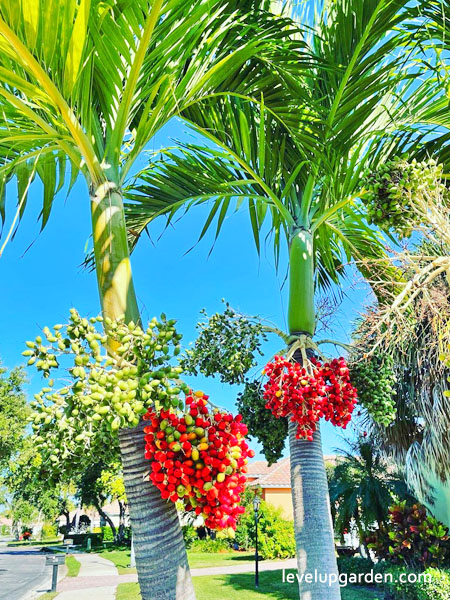
They also look great on porches and patios. Ideal for tight or compact spaces, such as near sidewalks or driveways. This palm does not take up much space and will not get too big.
Its crown, however, is large enough to create a shady relaxing area beneath it. It can be strategically placed by the pool, garden, or driveway to create heat-relieving shade.
Best of all, Christmas palms are very easy to care for and don’t require much attention. All you have to do is decide where the Christmas Palm will look its best. Then you will have a beautiful presence of a mature, elegant palm tree in your yard or house.
The top of the Christmas Palm has a lush canopy filled with 10 to 12 arching leaves. The trunk also has a distinctive pattern of blackish rings where old leaves used to be.
Then, in the summer, small green flowers bloom and eventually begin to develop into round green fruits. These fruits turn scarlet in late fall, around December, and look like Christmas ornaments, hence the name.
Do you think this is the ideal tree for your beautiful yard and garden?
VI. Frequently Asked Questions
How tall do Christmas palms get?
Over time, Christmas palms will grow to 25 feet tall, with a canopy spread of 5 to 8 feet and a trunk diameter of 6 inches.
What does a Christmas palm tree look like?
It has a smooth, slender gray trunk with a slightly swollen base and a ring of old leaf scars. It can be planted singly or in groups of two or three. The bright green crown shaft supports a crown of 10-12 pinnate leaves.
Can Christmas palms grow in pots?
Christmas palms look great on patios and indoors, and are a great indoor container plant.
